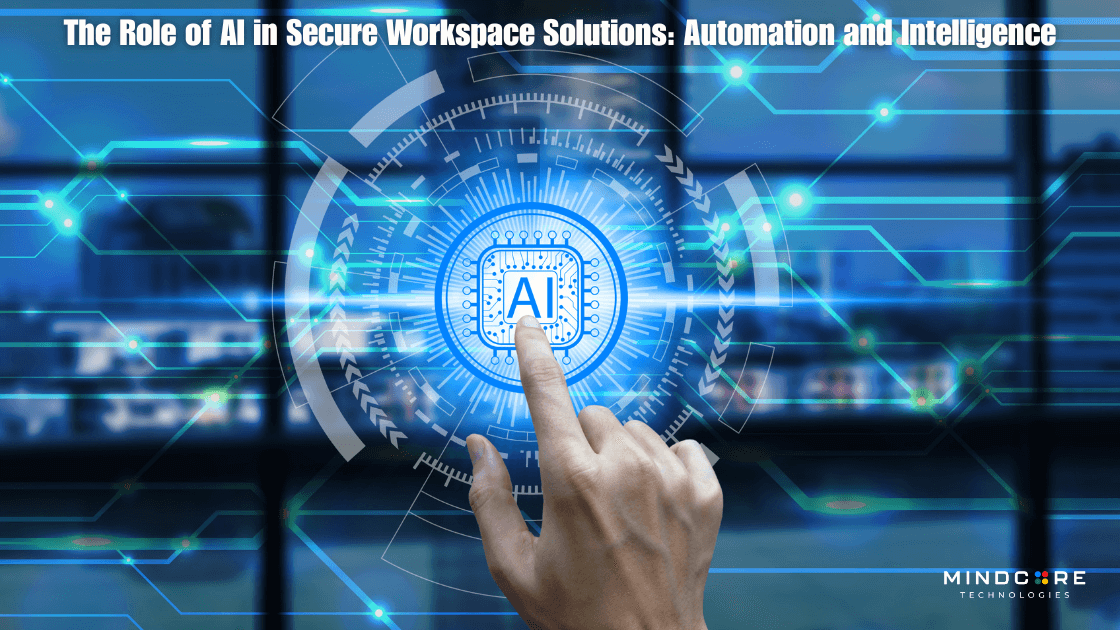Artificial intelligence isn’t just a trendy phrase anymore. It’s deeply embedded in business considerations for data protection, workflow balancing, and hybrid team management. Secure workspace solutions are already enabling businesses to stay productive and secure, but when these are enhanced with artificial intelligence, they grow even smarter.
This blog will discuss how artificial intelligence brings intelligence and automation into the secure workspace arena. Threat detection, task simplification, access personalization, and thinking ahead for businesses will be covered.
Smarter Security Starts With Smarter Tools
Let’s start with the basics. A secure workspace solution is a controlled environment within which users are able to access files, applications, and data without ever exposing the confidentiality or availability of any company systems. This constitutes the drawing together of technology such as virtual desktops, zero-trust network access (ZTNA), and endpoint protection.
Yet, one of the best security workspaces requires constant attention. Threats change rapidly. Teams would grow. People would work from anywhere at any time. That is where artificial intelligence instrumentation brings in its scene. It first observes, learns, then responds much more rapidly than the human team could.
AI for Threat Detection and Prevention
Cyberattacks are rarely predictable. They can appear like legitimate logins or normal file accesses. The ability to detect cyber attacks through patterns, rather than just known signatures, is aided by AI. The AI then ‘learns’ what is regarded as ‘normal’ behavior and flags anything that looks questionable.
Consider scenarios in which someone logs in at odd hours from a new location and tries to access sensitive files they normally won’t touch; AI detects these kinds of events. And it blocks their access or alerts the security team in no time.
This level of detection supports zero-trust security models. Every request is verified, and nothing is assumed safe. AI makes that process faster and more accurate.
This intelligence will be tightly integrated with platforms built around core functions, including those focused on VDI, ZTNA, and isolation at the endpoint.
Automation: Cutting Repetitive Workload
Thus, alerts, patches, updates, and policy enforcement are the daily routines of IT teams. If an operation is not automated, it can consume a lot of precious time. AI takes the repetitive task and performs it carefully.
AI helps automate tasks like:
- Patch and update management – Keeps systems up to date without manual input
- Policy enforcement – Applies security policies in real time
- Suspicious activity alerts – Automatically flags and quarantines risky behavior
- Resource allocation – Dynamically reallocates bandwidth or compute power in real time based on utilization
For scaling businesses, this means that IT does not have to scale at the speed of the company. One out of many reasons why secure workspace solutions helps teams be efficient yet maximize low operational cost.
User Behavior Analytics and Intelligent Access
AI doesn’t just react to threats—it helps prevent them by learning how people normally behave. That’s called user behavior analytics (UBA). It helps systems decide what’s safe and what’s risky.
Here’s how it works:
- The system tracks logins, file access, and app usage.
- It builds a profile for each user.
- If someone does something out of the ordinary, it takes action—limiting access, asking for re-authentication, or flagging for review.
This is especially helpful for remote teams, contractors, and global workforces. Instead of granting everyone the same permissions, secure workspaces now enable smarter, more customized access based on specific roles and needs.
It also supports compliance efforts by showing regulators that access decisions are based on logic and not just guesswork. That ties into many regulatory compliance frameworks like ISO 27001 and HIPAA.
How AI Supports Compliance Without Extra Burden
Compliance is one of the hardest parts of IT. Rules change, audits happen, and the pressure to stay ready never stops. AI helps by keeping an eye on everything in real time and creating the kind of reports auditors want to see.
AI-driven compliance features include:
- Session tracking and recording – Logs every user action for review
- Real-time policy enforcement – Automatically blocks non-compliant behavior
- Audit-ready reporting – Generates logs and summaries for regulators
- Rule-based alerting – Flags anything that goes outside compliance boundaries
Businesses in regulated industries like healthcare, legal, or finance benefit from this the most. Instead of adding more manual checks, they rely on AI to ensure the system is always audit-ready.
Smarter Workflows with AI-Powered Tools
AI isn’t only for security. It improves how people work. For example:
- It recommends apps based on previous usage
- Allocates cloud resources automatically
- Prioritizes bandwidth for more critical tasks
- Flags tools that are slowing down performance
These AI-driven improvements lead to a better user experience and smoother operations. And with hybrid work environments becoming the norm, speed and performance are more important than ever.
AI also supports AI and human-in-the-loop workflows, where systems make suggestions but let humans decide. This keeps work fast and secure while preserving control.
What Companies Are Doing With AI Now
In real-world use cases, companies are using AI in different ways:
- A healthcare group uses behavior analytics to protect patient data and automatically log access.
- A fintech company flags abnormal payment behavior before it becomes fraud.
- A remote creative agency uses AI to prioritize traffic for design tools, avoiding lag during peak hours.
These stories align with what we’ve seen across our secure workspace case studies, showing how different industries adapt AI to their specific needs.
Challenges to Watch Out For
AI is powerful, but not magic. There are a few things to keep in mind:
- Data privacy: Make sure AI isn’t analyzing more than it should.
- Transparency: AI decisions should be explainable.
- Cost: Advanced tools may come at a premium, so businesses need to assess ROI.
Choosing the right platform matters. A strong provider will help you balance automation with oversight.
The Future of AI in Secure Workspaces
AI is just getting started. Future updates will include:
- More predictive analytics
- Stronger integration with zero-trust models
- AI tools that adjust settings based on business goals
As emerging trends in secure workspace tech continue to evolve, AI will play a central role in how platforms adapt and scale.
Final Thoughts
AI brings the edge modern teams need. It helps secure workspaces stay fast, safe, and smart. From automated threat detection to intelligent access controls, it removes friction while keeping protection strong.
When AI works behind the scenes, your team gets more done—without compromising on security. That’s the kind of transformation that makes secure workspace solutions more than just an IT upgrade. It becomes a smarter way to run your business.
If you’re planning to implement AI-powered tools, make sure your workspace solution is ready to support them. The right setup today will keep you ahead of tomorrow.


